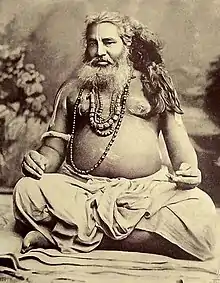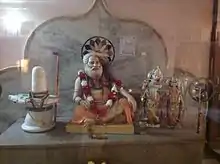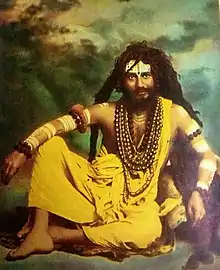Bijoy Krishna Goswami
Bijoy Krishna Goswami (Bengali: বিজয় কৃষ্ণ গোস্বামী) (2 August 1841 – 1899)[1] was a prominent Hindu social reformer and religious figure in India during the British period.[2]
Śrī Bijoy Krishna Goswami / Śrī Jatia Baba / Achyutananda Paramahamsa | |
|---|---|
 | |
| Personal | |
| Born | Bijoy Krishna Goswami 2 August 1841 Shikarpur village, Nadia district, India |
| Religion | Hinduism |
| Parents |
|
| Known for | Expounded Gaudiya Vaishnavism, Bhakti yoga |
| Philosophy | Bhakti yoga, Achintya Bheda Abheda |
| Religious career | |
| Guru | Brahmananda Paramahamsa (mantra guru) |
| Disciples | Bipin Chandra Pal, Ashwini Kumar Dutta, Satish Chandra Mukherjee and others |
| Part of a series on | |
| Hindu philosophy | |
|---|---|
 | |
| Orthodox | |
|
|
|
| Heterodox | |
|
|
|
Brahmo Samaj was started at Calcutta on 20 August 1828 by Raja Ram Mohan Roy and Debendranath Tagore as a reformation of the prevailing Brahmanism of the time (specifically Kulin practices). From the Brahmo Samaj springs Brahmoism, the most recent of legally recognised religions in India and Bangladesh, reflecting its foundation on reformed spiritual Hinduism with vital elements of Judeo-Islamic faith and practice.[3][4] Gosaiji's disillusionment from Brahmo Samaj led him to study the Chaitanya Charitamrita, a biography detailing the life and teachings of Sri Chaitanya Mahaprabhu (1486–1534), a Vaisnava saint and founder of the Gaudiya Vaishnava Sampradaya.[5]
Bijoy Krishna Goswami belonged to the "Advaita Family" and was the 10th descendant of Advaita Acharya, personal teacher and associate of Chaitanya Mahaprabhu.
Prophecy of appearance
The prophecy of the appearance of Prabhupad Sri Bijoy Krishna Goswami can be found in the text, Chaitanya Mangala written by Lochana Dasa and in the text, Adwaitya Abhisaap written by Paramananda Dasa. It is written by Lochana Dasa and Paramananda Dasa that during his Leela at Nabadwip, Lord Sri Chaitanya Mahaprabhu was travelling towards Sri Vrindavan in divine ecstasy, Nityananda Prabhu, however, diverted the lord from Sri Vrindavan and took him to Sripad Advaita Acharya's residence, in Shantipur. Lord Chaitanya Mahaprabhu stayed in Shantipur for ten days and then ignoring the tearful eyes of Shantipur's residents and grief-stricken requests from his mother, Sachi Devi; He left Shantipur for Jagannath Temple, Puri. Advaita Acharya could not bear the pangs of separation from Mahaprabhu, and in anticipation of parting, Adwaitya Acharya in a fit of grief cursed Mahaprabhu saying - "You have stayed here for ten days, but in this incarnation, your work will remain incomplete, you have to re-incarnate in my family as my tenth generation."
Gosaiji appeared in Shantipur as a tenth generation successor of Sripad Adwaitya Acharya.
Early life
Prabhupad Sri Bijoy Krishna Goswami (Gosaiji) was born on 2 August 1841 Shikarpur (Nadia), to Ananda Kishore Goswami and Swarnamoyee Devi. Desirous of a child, Ananda Kishore Goswami Prabhu travelled from Shantipur to Jagannath Temple, Puri, performing dandavat prostration all along the way. This method of travelling took him one and a half-year to reach Puri. The night he arrived at the Jagannath Temple, Puri, it is believed that he dreamt of Jagannath Swami, who promised him that he would take birth as his son. Thus, assured Ananda Kishore Goswami returned home to Shantipur. It is a typical pattern for saints to be born outside the confines of homes. Lord Chaitanya Mahaprabhu was born under a neem tree, Lord Jesus Christ was born in a manger, and Gautama Buddha was born in Lumbini garden likewise Gosaiji too was born in a colocasia thicket at Shikarpur (Nadia).
The family deity worshipped in the Goswami household was Sri Shyamsundar. Gosaiji later recounted that as an infant, Shyamsundar would appear before him and became his playmate. This sakhyabhāva (the attitude of a friend) with Shyamsundar would remain with Gosaiji throughout in his life.
Ananda Kishore Goswami passed away on 1844 AD, entering into maha bhava samadhi while reciting the Srimad Bhagavatam; Gosaiji was then only three years old. Goswamiji started his academic life in 1850 AD, enrolling in the Bhagwan Sarkar's Sanskrit school at Shikarpur. He also studied Vedanta under the tutelage of Acharya Krishna Gopal Goswami. He later joined the Calcutta Sanskrit College, during this time he married Ramchandra Bhaduri's eldest daughter Yogmaya Devi. It was a tradition in the Goswami family of becoming hereditary spiritual preceptor of devoted families. In keeping with the culture, Gosaiji once visited the family of a disciple, who begged him for redemption. Gosaiji was shocked; he thought - "How can I provide salvation when I am myself bound to Saṃsāra?" ; Gosaiji consequently, left the ancestral tradition of spiritual mentorship, and in the year 1860 AD joined the Calcutta Medical College to pursue a career in medicine. During those times, white supremacy was very much prevalent in British India. Infuriated by the racist comments made by a British professor, Gosaiji organised the first student strike in British India. The mediation of Sri Ishwar Chandra Vidyasagar brought the situation under control, but a disillusioned Gosaiji left his studies at the medical college and instead became a homoeopathy medicine practitioner. During his wanderings as a homoeopathy doctor, Gosaiji's religion fervour grew and under the influence of Acharya Devendra Nath Tagore, he renounced his Hindu heritage and joined the Brahmo Samaj.
Life as a Brahmo preacher
Gosaiji was an Acharya of the Adi Brahmo Samaj by the year 1864. As the Brahmo movement began to spread, there was a clash between the elderly conservative Adi Brahmo Samaj members led by Acharya Devendranath Tagore and the fresh members of the samaj led by Keshub Chandra Sen. As a result, Gosaiji resigned the position of acharya of the Adi Brahmo Samaj and joined Keshub Chandra Sen's new samaj called the Brahmo Samaj of India. As a member of the new Brahmo Samaj, Gosaiji took upon the duties of education of women and the abolition of child marriage. During this time he worked with Iswarchandra Vidyasagar to achieve the prohibition of child marriage. Aiming to educate the women of India, he started contributing to Bengali magazines like Bamabodhini -edited by Umesh Chandra Dutta, Tattwabodhini, Dharmatattwa etc. His writings in Bamabodhini magazine, under the pseudonym "Ashabati", received widespread attention and adoration; these writings were compiled later in a book called "Asahabatir Upakhan".
The year 1874 saw the emergence of the sankirtan movement in Brahmo Samaj premises, due to the efforts of Gosaiji. Gosaiji composed numerous Brahmo songs during this period. In this period Gosaiji started preaching the Brahmo way of worship throughout India, he visited interior parts of Bihar, Uttar Pradesh, Assam and Punjab with the sermon of Brahmoism.
The years between 1874-1878 was the most trying time in Gosaiji's life. As a preacher, he walked through the length and breadth of India, sometimes sustaining himself by only drinking water and eating the mud from river banks. There was a second schism in the Brahmo Samaj in May 1878, when Keshub Chandra Sen married his underage daughter to the prince of Cooch Bihar who was also a minor. Gosaiji, who had spent his life as a Brahmo preacher advocating against child marriage staunchly opposed this act. Subsequently, Brahmo Samaj of India split into Navavidhan Brahmo Samaj led by Keshub Chandra Sen and Sadharan Brahmo Samaj which included [https://www.thebrahmosamaj.net/founders/sivnath.html Sivnath Shastri, Ananda Mohan Bose, Gosaiji and others. This split in Brahmo Samaj caused deep anguish to Gosaiji. He soon realised that the Brahmo method of approach towards God-realisation through logic and reasoning was insufficient. Once while sermonizing in a province of Punjab, he was deeply disturbed by lust; disgusted with himself, he decided to commit suicide by drowning himself in the waters of the Ravi. The fateful night when Gosaiji was about to end his life, it is believed that a mahatma miraculously appeared before him. The mahatma consoled him by saying that philosophical speculations, logic and reasoning cannot bring about God realisation. One can only realise God by the grace of a God-realised Guru. The mahatma also reassured Gosaiji by saying that his Guru is preordained and will reveal himself when the time comes. Thus encouraged, Gosaiji started searching for his divine preordained Guru.
Initiation into Ajapa Sadhana

In his search for a Guru, Gosaiji joined various sects and schools of Hindu orthodox spiritualism. He associated with disciplines as diverse as Baul, Kapalik, Kartabhaja etc. He met Sri Ramakrishna Paramahamsa in Dakshineswar during this period on 27 October 1882 AD. On seeing Gosaiji, Sri Ramakrishna remarked, "When the soul soars high in the sky, why to keep the body in a cage?" - The indication was that it was time for Gosaiji to resign from the duty-bound job of a priest of Brahmo Samaj and lead a free life of an ascetic. He also met other leading saints of that time including Yogiraj Gambhir Nath, Siddha Caitanya Das Babaji of Nabadwip, Siddha Bhagavan Das Babaji of Kalna and Mahatma Trailanga Swami.
Caitanya Das Babaji on being asked by Gosaiji about how to obtain Bhakti became emotionally ecstatic and replied - "Gosai, what did you say? You are the purveyor of Bhakti, and you ask how to get Bhakti? Whatever you may do now, I can see the marks of a devout Vaishnavite in you."
None of these mahatmas, however, agreed to become Gosaiji's Guru, they instead told him that his Guru is waiting for the opportune moment to reveal himself.
Gosaiji then met Mahatma Trailanga Swami in Benaras. A fascinating anecdote regarding this meeting was shared later by Gosaiji to his disciples. Gosaiji said that the first meeting with the mahatma left him flabbergasted - Tailanga Swami was worshipping Lord Shiva using his urine as the holy Ganga water!! The puritan Gosaiji attempted to leave without meeting the mahatma. However, Trailanga Swami caught up with him and asked him if he wanted initiation. Gosaiji refused to be initiated by the Swami, the burly mahatma then playfully lifted the able-bodied Gosaiji by the neck and took him to the Ganga and forcefully immersed him in the Ganga for three times, and initiated him with three mantras. One for regular repetition, the second for remembrance when he was in trouble and the third, to the astonishment of Gosaiji was the same "Kula-Mantra" (A traditional mantra that passes down from generation to generation in a family). The mahatma revealed that although he had initiated him, he was not his Guru. These mantras would help draw Gosaiji's Guru towards him, shortening his waiting time.
Finally, in the year 1883 AD, Gosaiji arrived at Akash Ganga hill at Gaya, where he ultimately obtained his Guru - Sripad Brahmananda Paramahamsadev. The incidents of the initiation of Gosaiji was later penned down by him in the Bamabodhini magazine where Gosaiji wrote under the pseudonym - Ashabati. Gosaiji writes that he and another yogi was staying at Akash Ganga hill in the ashram of Raghuvar Das Baba. One day when the ashram was empty, the local shepherds reported that an effulgent mahatma had arrived at the peak of AkashGanga hill. Gosaiji took some edibles and went to meet the mahatma. After a brief introduction, the mahatma revealed that his residence is at Manasarovar near Mount Kailash and he was the Guru, Gosaiji was searching for; taking Gosaiji on his lap, the mahatma initiated him and disappeared. Gosaiji immediately fell unconscious into a state of samadhi that lasted eleven days !! Raghuvar Das Baba looked after him during this period. After a brief period of sadhana at the Akash Ganga hill, Gosaiji at the direction of his Guru arrived at Benaras. After completing three days as a Brahmachari, he received sannyasa from Swami Hariharananda Saraswati in the year 1885 AD. Brahmo Bijoy Krishna Goswami thus made a complete reversal to Hinduism as the monk Achyutananda Saraswati.
Manifestation as SadhGuru
Return to society as Acharya Bijoy Krishna

Gosaiji spent a year of his life as an itinerant monk. According to the memoirs in the comprehensive book - শ্রী শ্রী সদ্ধগুরু সাঙ্গ (Sri Sri SadhGuru Sanga) Gosaiji started experiencing extreme irritation accompanied by a burning sensation while practising Ajapa Sadhana. This affliction resulted in the singeing of all his androgenic hair. At one point Gosaiji asked his Guru to relieve this affliction; Brahmananda Paramahamsadeb consequently asked him to relocate to Jawalamukhi in Himachal Pradesh and continue his practices there. Gosaiji thus travelled from place to place for a year, before his Guru finally asked him to return to society as a householder saint and take up the work of an acharya - preaching the Sri-Naam kirtan and initiating suitable candidates with the Ajapa Naam Sadhana.
Gosaiji thus returned to society and rejoined the Kolkata Brahmo Samaj as an acharya. All the incidents after that from 1886 AD to 1893 AD is recorded extensively by Srimad Kuladananda Brahmachari[6] in his Bengali journal - শ্রী শ্রী সদ্ধগুরু সাঙ্গ (Sri Sri SadhGuru Sanga).[7]
The spiritual experiences and practice of the Ajapa sadhana had changed Gosaiji to a great extent. He refused to conduct the duties of an acharya following the narrow sectarian Brahmo samaj process, thus resulting in antagonism within the samaj power structure. According to the letters by Gosaiji's disciple Srimat Kiranchand Darvesh (later collected and collated as Darvesh Darshan[8])during this time there was an assassination attempt on him by Trailokyanath Sanyal (Sadhu Chiranjeeb Sharma)of the Kolkata Brahmo Samaj. The assassination attempt failed, and subsequently, on 24 March 1886 AD, Gosaiji resigned his position from the Kolkata Brahmo Samaj and on the invitation of the members of the Dhaka Brahmo samaj travelled to Dhaka, Bangladesh to take over the duties of an acharya.
Gosaiji's mission as SadhGuru began in full earnest at Dhaka Brahmo Samaj. Brahmachari Kuladananda writes that every day the Brahmo Samaj grounds would be teeming with Hindu, Christian, Muslim and Brahmo devotees who would gather to hear Gosaiji speak. Most of the times, however, Gosaiji was not able to complete his speeches. Overflowing with divine love he would cry in ecstasy and would ultimately get immersed in maha bhava samadhi. Gosaiji's lectures during this time were later collected and published under the title বকত্রিতা ও উপদেশ (Bakatritā Ō upadēśa). Gosaiji also wrote books like করুণাকনা (Karuṇākānā) during this period. Shyama Kanta Pandita became the first disciple of Gosaiji, and gradually the number of initiates increased. Gosaiji's also initiated his spiritual successor Srimat Kuladananda Brahmachari in Dhaka during this time.
Life threatening ailment and meeting with Yogiraj Lokenath Brahmachari
While a Brahmo Acharya, Gosaiji travelled to Darbhanga, Bihar on 15 May 1887 A.D where he contracted double pneumonia. His condition deteriorated, and physicians lost all hope for his life. In this crisis, Gosaiji's disciple Shyamacharan Bakshi approached the famous mahatma Lokenath Brahmachari and begged him to save Gosaiji's life - Lokenath Brahmachari later revealed that he was Gosaiji's খুল্লতাত (father's younger brother). Kuladananda Brahmachari, in his journal, writes that while travelling from Goalundo Ghat to Darbhanga; Gosaiji's son Yogjeeban Goswami spotted Lokenath Brahmachari drifting in the air towards Darbhanga. Many other disciples of Gosaiji saw Lokenath Brahmachari, Brahmananda Paramahamsa (Gosaiji's Guru) and many other anonymous saints appear and disappear spontaneously near the bedside of the ailing Gosaiji. Against all speculations of Gosaiji's demise, Gosaiji regained full health; He arrived at Baradi, Narayanganj on 14 June 1887 A.D to pay his respects to Lokenath Brahmachari.
See also
References
- Kenneth W. Jones (1 May 1990). The New Cambridge History of India: Socio-religious reform movements in British India. Cambridge University Press. pp. 39–. ISBN 978-0-521-24986-7. Retrieved 6 July 2012.
- Prabhavananda (Swāmi); Swami Prabhavananda (1970). The Eternal Companion: Brahmananda; Teachings and Reminiscences, with a Biography. Vedanta Press. pp. 42–. ISBN 978-0-87481-024-0. Retrieved 6 July 2012.
- "Official Brahmo website". Brahmosamaj.in. Retrieved 15 October 2012.
- "Bangladesh Law Commission" (PDF). Retrieved 15 October 2012.
- Shandilya, Krupa. Intimate Relations: Social Reform and the Late Nineteenth-Century South Asian Novel, Chapter 2, note 12, Northwestern University Press, 2017ISBN 9780810134249
- "Shree Shree Kuladananda Brahmachari".
- "শ্রী শ্রী সদ্ধগুরু সাঙ্গ".
- "দরবেশ দর্শন".